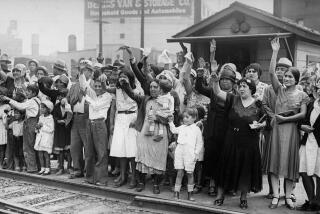Resettlement Program Ends in Disarray
- Share via
JAYAPURA, Indonesia — Abdul Hamad was living the Indonesian dream when he signed up for a government relocation program and left his crowded family home on Sulawesi island 12 years ago in search of a better life.
He and his young wife were shipped to Irian Jaya, the sparsely populated western half of New Guinea island that is controlled by Indonesia. They built a small house in a migrant hamlet, opened a kiosk and lived well.
Then, six months ago, his hopes were shattered. A mob of indigenous tribesmen angry about the incursions of newcomers attacked Hamad’s village, burned his house and killed his neighbor.
“They were jealous of our prosperity,” Hamad said. “But now we have nothing. Not even enough money to go home.”
Stories like this have become common as Indonesia’s government grapples with the simultaneous crises of an economic slump, ethnic fighting and separatist movements. Rising violence persuaded the year-old democratically elected government to end state resettlement programs that flourished during years of dictatorship.
Like America’s trailblazing frontiersmen, millions of Indonesians have for generations migrated to remote islands in this sprawling archipelago of 210 million people to carve new lives from the tropical wilderness.
With a handful of Indonesia’s 17,000 islands teeming with millions of landless and poor people, migration seemed the perfect answer to the government to reduce overcrowding and populate virgin lands.
But the bold social experiment, known as “transmigration,” has been sputtering recently, with escalating tensions between the migrants and indigenous populations erupting into deadly clashes.
In October, indigenous gangs decapitated several migrants and carried their severed heads on sticks through the town of Pontianak on Borneo island.
Two weeks earlier in the town of Wamena in New Guinea’s central highlands, about 40 people, mostly migrants, were speared to death by separatist tribesmen.
“The problem is all over Indonesia,” said Philip Clarke, head of the U.N. World Food Program in Indonesia, which gives aid to thousands of people affected by ethnic violence. “One group does not like the other. The tensions never stop.”
Limited migration started under Dutch colonial rule in 1905 to offset population growth on the country’s main island of Java and to supply much-needed labor to sugar and rubber plantations on outer islands.
But the program was accelerated in the late 1960s under former dictator Suharto, who relocated more than 7.5 million people in an attempt to counterbalance indigenous separatists in remote provinces and boost the country’s food supply.
He established a migration ministry that used promises of free land and houses to lure millions of people away from their ancestral homes.
The program resulted in numerous success stories, with previously unemployed laborers establishing productive farms. But there were also several failures, and at least 45% of the settlers could not raise their standard of living above a subsistence level, government officials said.
The World Bank helped finance the project for a decade before pulling out in 1989 amid criticism that some of the migrants were forced to move.
Environmentalists criticized the program, saying that tropical rain forests were cut down to make way for the new communities and that many settlers turned to illegal mining and logging.
Local tribesmen saw the newcomers as depriving them of work and education. Widespread appropriation of land for new settlements, forestry concessions, mining projects and farming led to frequent conflict between security forces and dispossessed natives.
In Irian Jaya province, on New Guinea, the indigenous population also resented the settlers for introducing Islam into a predominantly Christian region.
The province’s capital, Jayapura, looks much like any other Indonesian town, dotted with mosques and holding a local bureaucracy and police force dominated by Muslims from Java. The indigenous, mostly Christian, peoples have become a minority.
The influx of settlers to Irian Jaya and other provinces was viewed as neocolonialism and fed resentment toward Java island, source of most migrants and home to more than half of Indonesia’s population and to the national capital, Jakarta.
Suharto’s strong army suppressed most unrest, but after the dictator’s downfall in May 1998 and the election of a reformist government, tensions are starting to boil over.
“Suharto was able to put a lid on the tensions,” said Asmara Nababan, a human rights activist. “But the new government is not able to repress the people like he did.”
As a result, Indonesia’s government not only ended the migration program but has started removing migrants from conflict areas.
“Transmigration is finished,” said Alhilal Hamdi, minister in charge of looking after settlers. “The only people being relocated now are refugees. We are having to clean up the mess that Suharto’s government left.”
*
World Bank regional reports: https://www.worldbank.org/html/extdr/regions.htm
More to Read
Sign up for Essential California
The most important California stories and recommendations in your inbox every morning.
You may occasionally receive promotional content from the Los Angeles Times.













